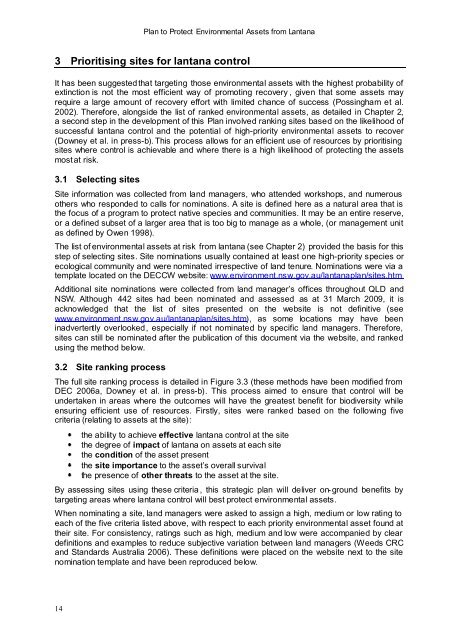Plan to Protect Environmental Assets from Lantana - Weeds Australia
Plan to Protect Environmental Assets from Lantana - Weeds Australia
Plan to Protect Environmental Assets from Lantana - Weeds Australia
You also want an ePaper? Increase the reach of your titles
YUMPU automatically turns print PDFs into web optimized ePapers that Google loves.
<strong>Plan</strong> <strong>to</strong> <strong>Protect</strong> <strong>Environmental</strong> <strong>Assets</strong> <strong>from</strong> <strong>Lantana</strong><br />
3 Prioritising sites for lantana control<br />
It has been suggestedthat targeting those environmental assets with the highest probability of<br />
extinction is not the most efficient way of promoting recovery , given that some assets may<br />
require a large amount of recovery effort with limited chance of success (Possingham et al.<br />
2002). Therefore, alongside the list of ranked environmental assets, as detailed in Chapter 2,<br />
a second step in the development of this <strong>Plan</strong> involved ranking sites based on the likelihood of<br />
successful lantana control and the potential of high-priority environmental assets <strong>to</strong> recover<br />
(Downey et al. in press-b). This process allows for an efficient use of resources by prioritising<br />
sites where control is achievable and where there is a high likelihood of protecting the assets<br />
mostat risk.<br />
3.1 Selecting sites<br />
Site information was collected <strong>from</strong> land managers, who attended workshops, and numerous<br />
others who responded <strong>to</strong> calls for nominations. A site is defined here as a natural area that is<br />
the focus of a program <strong>to</strong> protect native species and communities. It may be an entire reserve,<br />
or a defined subset of a larger area that is <strong>to</strong>o big <strong>to</strong> manage as a whole, (or management unit<br />
as defined by Owen 1998).<br />
The list of environmental assets at risk <strong>from</strong> lantana (see Chapter 2) provided the basis for this<br />
step of selecting sites. Site nominations usually contained at least one high-priority species or<br />
ecological community and were nominated irrespective of land tenure. Nominations were via a<br />
template located on the DECCW website: www.environment.nsw.gov.au/lantanaplan/sites.htm<br />
Additional site nominations were collected <strong>from</strong> land manager’s offices throughout QLD and<br />
NSW. Although 442 sites had been nominated and assessed as at 31 March 2009, it is<br />
acknowledged that the list of sites presented on the website is not definitive (see<br />
www.environment.nsw.gov.au/lantanaplan/sites.htm), as some locations may have been<br />
inadvertently overlooked, especially if not nominated by specific land managers. Therefore,<br />
sites can still be nominated after the publication of this document via the website, and ranked<br />
using the method below.<br />
3.2 Site ranking process<br />
The full site ranking process is detailed in Figure 3.3 (these methods have been modified <strong>from</strong><br />
DEC 2006a, Downey et al. in press-b). This process aimed <strong>to</strong> ensure that control will be<br />
undertaken in areas where the outcomes will have the greatest benefit for biodiversity while<br />
ensuring efficient use of resources. Firstly, sites were ranked based on the following five<br />
criteria (relating <strong>to</strong> assets at the site):<br />
the ability <strong>to</strong> achieve effective lantana control at the site<br />
the degree of impact of lantana on assets at each site<br />
the condition of the asset present<br />
the site importance <strong>to</strong> the asset’s overall survival<br />
the presence of other threats <strong>to</strong> the asset at the site.<br />
By assessing sites using these criteria, this strategic plan will deliver on-ground benefits by<br />
targeting areas where lantana control will best protect environmental assets.<br />
When nominating a site, land managers were asked <strong>to</strong> assign a high, medium or low rating <strong>to</strong><br />
each of the five criteria listed above, with respect <strong>to</strong> each priority environmental asset found at<br />
their site. For consistency, ratings such as high, medium and low were accompanied by clear<br />
definitions and examples <strong>to</strong> reduce subjective variation between land managers (<strong>Weeds</strong> CRC<br />
and Standards <strong>Australia</strong> 2006). These definitions were placed on the website next <strong>to</strong> the site<br />
nomination template and have been reproduced below.<br />
14

















